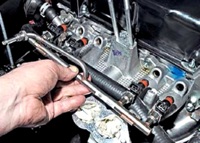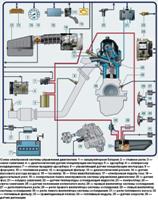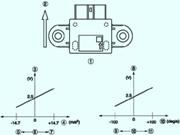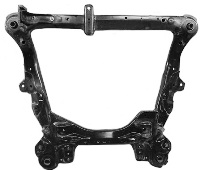Vibrations are caused by a sequence of pulses. In the case of vibrations related to the speed of movement, these impulses are generated by an imbalance of some element rotating with the wheel, which is transmitted to the corresponding wheel suspension
The frequency of these impulses changes with the speed of movement.
Usually, they are extinguished due to a specially selected design of suspension elements and supports, in addition to vibrations of a strictly defined frequency of “natural suspension oscillations”, which depend on its longitudinal stiffness.
The moments of natural oscillations of the front and rear suspensions are usually very different and can be expressed in terms of the speed of movement, since the "rolling radius" of the wheels does not change.
The number of impulses per revolution of a wheel is the ratio between the moment of occurrence of natural oscillations of the corresponding suspension, expressed in terms of driving speed, and the speed of movement at the moment of occurrence of vibrations (see the table of occurrence of natural oscillations of the front and rear suspensions of the vehicles covered by this Technical Note ).
There are two types of imbalance.
- – Unbalance: mass imbalance = one impulse per wheel revolution.
- – Radial runout: geometric deformation = one or more pulses per revolution of the wheel.
Vibrations occur on the following components and parts:
- - rotating elements (tires, wheel disks, decorative wheel caps, brake mechanisms, wheel drive shafts, hollow semi-axial gear of an open type manual gearbox);
- - damping elements (shock absorbers, mounts and / or damping elements of the suspension, subframe, rack and pinion steering, steering column, seats, etc.).
Determining the vibration source
Determining the source of vibrations is also an element of diagnostics, but it is not systematized.
Vibrations are transmitted through the suspension and further through the steering knuckle (center of rotation).
Then, their "path" (or "transfer function") depends on the energy of the vibrations, the nature of the connections between the parts (tightening of the fasteners, the state of the vibration damping elements, etc.), their rigidity, or on various possible components of the impulses that cause vibrations.
In some cases, the vibration on the steering wheel is due to the destruction of the engine mounts.
Rubber elements of supports fail after long-term operation.
Vibration from the twisting elements of the engine is strongly felt on the steering wheel.
It can be assumed that in most cases of transmission of vibrations to the steering wheel, they come from the front suspension and are transmitted through the steering.
But this is not an absolutely universal rule.
The cause of steering wheel vibrations can be some very specific rear wheel tire defects.
Vibrations are caused by a sequence of impulses (shocks) coming from elements rotating with the wheel.
Vibrations are caused by two kinds of causes:
- – mass imbalance;
- – one pulse per wheel revolution.
The front and rear suspensions have characteristics based on which diagnostics are carried out.
They dampen vibrations, except for those that have a frequency of "natural oscillations".
The moment of occurrence of natural oscillations of the suspension depends on its longitudinal stiffness.
The frequency of oscillation is determined by the speed of the vehicle.
The moments of occurrence of natural oscillations of the front and rear suspensions differ from each other.
Vibration diagnostics allows you to determine which suspension (front or rear) they come from, and, in particular, determine the number of impulses per wheel revolution.
These initial diagnostic data serve as a guide for choosing the necessary technical intervention.
It is therefore important to obtain this data from the owner or have it road tested.
The amount of unbalance needed to create perceptible vibrations is about:
- - 20g for wheels (tires on 15" rim);
- - 100 g for brake disc or drum;
- - 500 g for the wheel hub;
- - 1.16 kg for the wheel drive shaft.
Some types of vibrations caused by the operation of the engine can be mistaken for vibrations associated with the speed of movement.
In this case, the appearance of vibration is most likely associated with engine speed or load.
This can only be verified by reproducing the fault with an appropriate check.
Special cases of vibrations
A possible cause of vibrations is a defect in the design of the tires.
Such a defect is outwardly invisible. To identify it, you must perform the appropriate check.
NOTE
If there is a defect in the design of the tire, balancing weights of a large mass (50 g or more on one side of the wheel rim) are usually installed on the wheel. "Hardening" of suspension shock absorbers.
There are cases of "Vibrations" disappearance only on roads with a particularly smooth surface (on freeways or new express lanes).
The friction in the shock absorbers combined with the stiff suspension can cause vibration-like bounces.
This phenomenon will stop under normal driving conditions (during a normal overtaking maneuver, on rougher road surfaces, etc.).
Check the tightening torques of the threaded connections and the condition of the hangers.
After installing new parts or on a new car, this phenomenon gradually disappears as the parts are “lapped in”.
Excessive tire pressure.
When tires are overinflated, a rebound phenomenon occurs, which can be mistaken for vibrations.
Troubleshooting algorithms
Check
Check 1: road test to determine the nature of the vibrations and their sources.
Mark the position of the tire on the wheel rim (for less visibility, the mark is applied to the metal on the inside of the wheel)
Reproduce vibrations, make sure they are related to the speed (reproduce vibrations in several gearbox gears).
Write down the speed range in which vibration occurs.
Check the effect of braking on vibrations:
– in the area of vibration rates, slow down the car slightly (until the brake pads touch the disc) and determine the presence or absence of a change in vibrations, maintaining the speed.
Check the effect of changing the engine torque (pull-in movement when shifting into lower gears):
– in the area of vibration occurrence rates, change the engine load (to create “retract” driving conditions, then when switching to lower gears) and determine the effect of this change on vibrations.
Determine which of the suspensions the vibration comes from and the number of impulses per revolution of the wheel according to the table of the rates of occurrence of natural oscillations of the suspensions.
Test 2: road test to determine the rate at which natural oscillations of the suspensions occur.
This test is to determine the rate of occurrence of natural oscillations of the suspensions by artificially creating an imbalance (obtaining one impulse per wheel revolution) on one of the front wheels, then on one of the rear wheels.
The best solution is to use a different vehicle (same model, but not necessarily the same engine) for this test.
Install an additional 50 g balance weight on one of the front wheels and mark its position (the position of the weight on the circumference of the wheel disc does not matter).
Leave the old weights or the weight in place. Carry out a road test and record the speed range where the vibrations appear.
The result corresponds to the rate of occurrence of natural oscillations of the front suspension of the tested vehicle.
Remove the extra weight from the front wheel and install it on one of the rear wheels.
Road test again and note down the speed range where the vibrations appear.
The result corresponds to the rate of occurrence of natural oscillations of the rear suspension of the tested vehicle.
Compare the result of test 1 with test 2 and determine which suspension is the vibration source and the number of pulses per wheel revolution.
Check 3: road test to determine if there are structural defects in the tires.
A possible cause of vibration is a defect in the internal construction of the tires.
Such a defect is outwardly invisible.
To identify it, you should rearrange the front and rear wheels (put the left wheels on the left, the right wheels on the right), having previously recorded the vibration speed interval when performing test 1, and perform test 1 again.
If, during this new test, the range of vibration occurrence rates has changed and began to correspond to the rate of occurrence of natural oscillations of another suspension, then the defect is related to the tires or wheel balancing.
If there is a defect in the design of the tire, balancing weights of a large mass (50 g or more on one side of the wheel rim) are usually installed on the wheel.
The reliability of test 3 results is based on the difference between the natural oscillation speeds of the front and rear suspensions.










